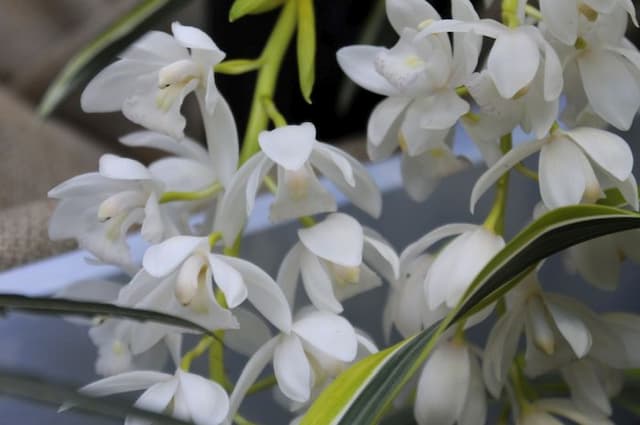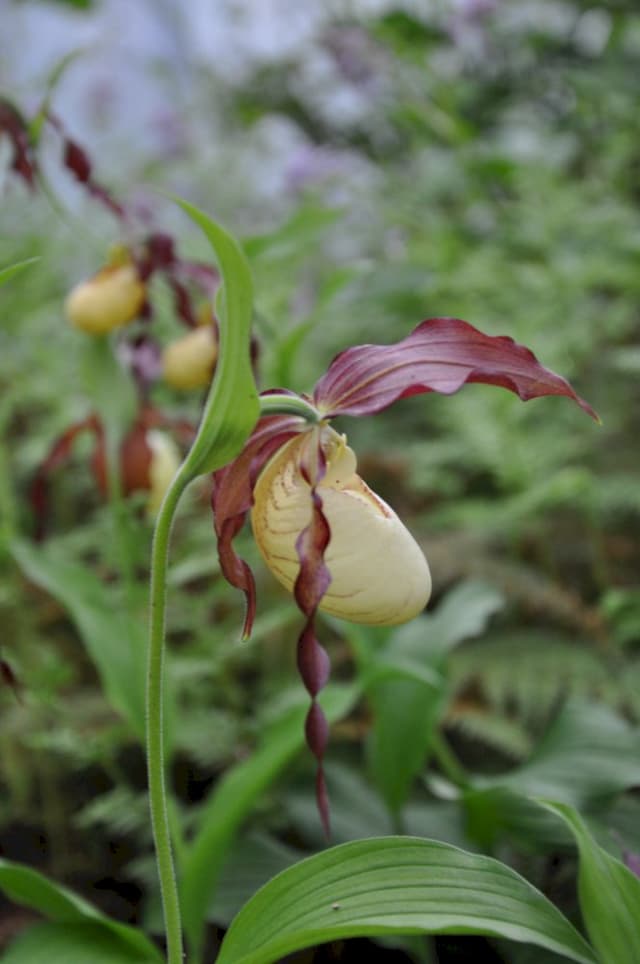Chocolate Orchid Oncidium Sharry Baby gx

ABOUT
The Oncidium Sharry Baby, commonly known as the Chocolate Orchid, is admired for its distinctive chocolate-like scent, particularly strong when the blooms first open. The plant itself sports a sympodial growth habit, with pseudobulbs that serve as storage organs for moisture and nutrients, giving the plant a swollen appearance at the base of each leaf cluster. The leaves of the Chocolate Orchid are typically narrow and lengthy, presenting a vibrant green hue. This greenery provides a lush backdrop for the main attraction: the blooms. The flowers emerge on long, arching sprays that produce a cascade of color. The blossoms of Sharry Baby are small to medium in size and exhibit a combination of reddish-brown and pinkish hues, often with a pattern that may remind one of a leopard's spots. The petals and sepals are slender and may have undulating edges, adding to the plant's exotic charm. Central to its appeal and name, the fragrant flowers emit a sweet aroma reminiscent of chocolate, especially noticed during the morning hours. As an orchid with a bountiful flowering habit, Sharry Baby is a popular choice among plant enthusiasts due to its olfactory delight and striking visual presentation.
About this plant
 Names
NamesSynonyms
Chocolate Orchid, Sharry Baby Orchid
Common names
Oncidium Sharry Baby gx.
 Toxicity
ToxicityTo humans
The Chocolate Orchid is generally considered non-toxic to humans. Ingesting parts of the plant is not known to cause poisoning or harmful effects. However, it is always advisable to keep plants out of reach of small children who might chew on them, as individual allergic reactions cannot be entirely ruled out.
To pets
The Chocolate Orchid is not known to be toxic to pets. Ingesting parts of this plant should not lead to poisoning or severe adverse effects in animals such as cats and dogs. However, as with any non-food plant, consumption of large quantities could potentially cause mild gastrointestinal upset simply due to the novelty and fiber content. It is always best to prevent pets from eating houseplants to avoid any potential issues.
 Characteristics
CharacteristicsLife cycle
Perennials
Foliage type
Evergreen
Color of leaves
Green
Flower color
Mixed
Height
1-2 feet [30-60 cm]
Spread
1 foot [30 cm]
Plant type
Orchid
Hardiness zones
9
Native area
South America
Benefits
 General Benefits
General Benefits- Ornamental Appeal: The Oncidium Sharry Baby, commonly known as the Chocolate Orchid, has distinctive and attractive blooms that can add aesthetic value to any space.
- Fragrance: This orchid is well-known for its sweet chocolate-like scent, which can be a delightful addition to indoor environments.
- Long Blooming Period: The Chocolate Orchid has a long flowering season, providing consistent beauty over an extended period.
- Stress Reduction: The process of caring for an orchid such as the Chocolate Orchid can be therapeutic, potentially reducing stress and promoting relaxation.
- Hobby Interest: Growing orchids, including the Chocolate Orchid, can become a rewarding hobby leading to increased knowledge of botany and horticulture.
- Gift Potential: Due to its unique chocolate scent and beautiful blooms, the Chocolate Orchid makes an excellent gift for plant enthusiasts and novices alike.
 Medical Properties
Medical PropertiesThis plant is not used for medical purposes.
 Air-purifying Qualities
Air-purifying QualitiesThis plant is not specifically known for air purifying qualities.
 Other Uses
Other Uses- Perfumery Ingredient: The Sharry Baby orchid is known for its chocolate-like scent, which is sometimes used in the formulation of perfumes and scented products.
- Aromatherapy: Its sweet aroma is sometimes used for relaxation and stress relief in aromatherapy practices.
- Botanical Art: Enthusiasts of botanical illustration may choose this orchid for its unique appearance and color as a subject for their artwork.
- Photography: The exotic and vibrant appearance of the Sharry Baby orchid makes it a popular choice for photographers specializing in flora.
- Floral Arrangements: Sharry Baby is used in floral arrangements, particularly in tropical-themed or exotic floral designs.
- Educational Tool: This orchid can be used by educators to teach students about pollination and the diversity of plant reproductive strategies.
- Plant Competitions: Orchid enthusiasts may grow Sharry Baby orchids to enter them into orchid shows and competitions.
- Cultural Rituals: In some cultures, orchids like Sharry Baby can be used in various rituals and ceremonies for their beauty.
- Culinary Decoration: Although not edible, the flowers may be used as non-toxic decorative garnishes for high-end cuisine and desserts.
- Bee Attraction: The Sharry Baby orchid, with its enticing aroma, can be used in gardens to attract pollinators like bees.
Interesting Facts
 Feng Shui
Feng ShuiThe Oncidium orchid is not used in Feng Shui practice.
 Zodiac Sign Compitability
Zodiac Sign CompitabilityThe Oncidium orchid is not used in astrology practice.
 Plant Symbolism
Plant Symbolism- Charm & Beauty: The Sharry Baby Orchid, with its stunning and unique appearance, symbolizes charm and beauty, making it a popular choice for gifting on occasions that appreciate these traits.
- Sweetness: Known for its vanilla-chocolate scent, this orchid also represents the sweetness in life and relationships, highlighting pleasant feelings and experiences.
- Luxury & Splendor: Orchids have long been associated with luxury and splendor due to their exotic nature and the rich diversity of their species, including the Sharry Baby.
- Strength & Resilience: Despite their delicate appearance, orchids like the Sharry Baby are resilient and can thrive in various conditions, symbolizing endurance and the ability to overcome challenges.
 Water
WaterThe Chocolate Orchid should be watered approximately once a week, but the frequency can vary based on environmental conditions – only water when the top inch of the potting medium is dry. It prefers being watered with tepid water, allowing the liquid to drain freely from the pot's bottom. You should provide enough water to soak the medium thoroughly, which might be around one-quarter to half a gallon, depending on the pot size and the orchid's environment. During active growth periods, in warmer months, you might need to water twice a week, but always check the medium's moisture level before adding more water, to avoid overwatering and root rot.
 Light
LightThe Chocolate Orchid thrives in bright, indirect light away from direct sunlight, which can scorch its leaves. A spot near an east or west-facing window, where it can receive gentle morning or late afternoon sun, is ideal. Ensure the plant receives ample light without exposing it to harsh midday rays, as consistent, moderate lighting is key to promoting healthy growth and blooming.
 Temperature
TemperatureThe Chocolate Orchid prefers warm conditions, thriving at temperatures between 60 to 80 degrees Fahrenheit. Ensure the plant is not exposed to temperatures below 50 degrees Fahrenheit to avoid cold damage. Providing a consistent temperature within this range encourages optimal growth and flowering; however, the Chocolate Orchid can tolerate short periods of higher or lower temperatures as long as it is not exposed to sudden temperature changes.
 Pruning
PruningPrune the Chocolate Orchid to remove any dead or yellowing leaves and spent flower spikes, enhancing the plant's appearance and redirecting energy to healthy growth. Pruning is best done after the orchid has finished blooming, typically using sterilized pruning shears or scissors to make clean cuts without damaging healthy tissue. Cut back the flower spike to just above a node where an old flower was, encouraging the possibility of a secondary bloom. Prune dead or damaged parts any time of the year as you notice them to keep the plant healthy.
 Cleaning
CleaningAs needed
 Soil
SoilThe best soil mix for the Chocolate Orchid, or Oncidium Sharry Baby, consists of a mixture of fine bark, coarse perlite, and peat moss in equal parts to ensure good drainage and aeration. Aim for a slightly acidic to neutral pH between 5.5 and 7.
 Repotting
RepottingChocolate Orchids should be repotted every 2 to 3 years or when the potting medium starts to decompose and no longer provides good aeration. It's best to repot after the plant has finished flowering.
 Humidity & Misting
Humidity & MistingChocolate Orchids thrive in high humidity levels, ideally between 40% and 70%. These conditions help to mimic their natural tropical environment.
 Suitable locations
Suitable locationsIndoor
Provide bright indirect light and high humidity for indoor Chocolate Orchids.
Outdoor
Grow in dappled sunlight, protect from extreme weather, high humidity.
Hardiness zone
10-12 USDA
 Life cycle
Life cycleThe life cycle of the Sharry Baby orchid, commonly known as Oncidium Sharry Baby, begins with seed germination, which is a complex process that typically occurs in symbiosis with a mycorrhizal fungus. After germination, the plant develops into a protocorm—a small, photosynthetic organ that eventually gives rise to the orchid's roots and first true leaves. As the plant matures, it forms pseudobulbs, which function as storage organs and bases for the leaves and flower spikes. The Sharry Baby orchid reaches a flowering stage once a year under proper conditions, producing fragrant blooms that resemble miniature chocolate-scented flowers. After pollination, if it occurs, the flowers develop into seed capsules containing thousands of minute seeds, ready to disperse and potentially start the life cycle anew. In cultivation, the Sharry Baby orchid experiences periods of active growth and dormancy, which are governed by seasonal changes in temperature and light.
 Propogation
PropogationPropogation time
Spring-Early Summer
The Oncidium Sharry Baby, commonly known as the Chocolate Orchid, is best propagated through division, which can be carried out when repotting, typically in the springtime after the blooming cycle has finished. When dividing, ensure that each section has a good number of pseudobulbs, ideally at least three. Carefully separate the bulbs, making sure not to damage the roots too much, and plant each division in fresh orchid medium, ensuring they are stable and the base of the newest growth is level with the top of the potting medium. Water the divisions sparingly at first to reduce the risk of rot and create a humid environment to encourage root growth. It might take several weeks for the divisions to establish and start new growth.









